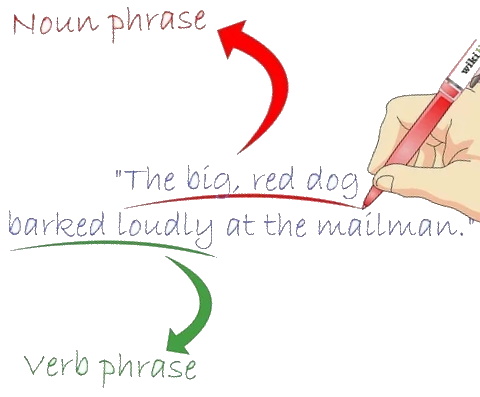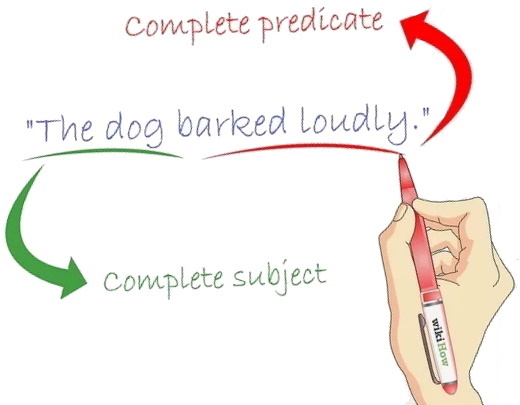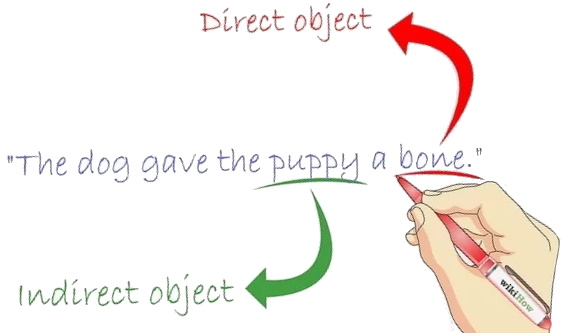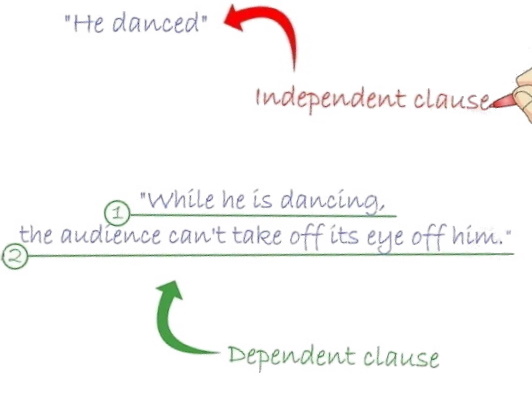A sentence is composed of words grouped into phrases and clauses. Analyzing (parsing) a sentence and its components helps you understand the function of each of its nouns, verbs, and modifiers in the sentence so you can write better sentences. You can determine the function of each component of a sentence from its position in the sentence, or you can organize the words into a diagram to graphically display their functions.
- Nowns
- Pronouns
- Verbs
- Adjectives
- Adverbs
- Prepositions
- Interjections
The words in a sentence are given names according to the type of function they serve in the sentence. There are 8 parts of speech:
Nouns are words that represent persons, places, or things. Examples include "boy," "girl," "cat", "dog", "grass", and "home".
Pronouns are words that stand in for nouns so they don't have to be repeated. Examples include "he," "she," "it," "you," "we," and "they."
Verbs are words that express action or state of being. Examples include "is"/"are", "do"/"does", "has"/"have", "perform", and "sing".
A form of verbs, called verbals, can serve as other parts of speech. Gerunds are verbals that act as nouns; they usually end in "-ing" (as in "acting," the profession). Participles are verbals that act as adjectives; they usually end in "-ing" or "-ed" (as in "melted" when describing melted chocolate).
Adjectives are words that describe, or modify, nouns. Examples include words representing size ("big", "huge", "small", "tiny"), color ("red", "green", "blue"), quantity ("one", "two", "three"), or condition ("good", "bad", "happy"). A special group of adjectives are called articles or determiners; these include "a", "an", and "the".
Adverbs are words that describe verbs, adjectives, or other adverbs. Many adverbs end in "–ly" ("quickly", "badly", "really"), but others do not ("very", "fast"). They describe how, when, where, why, and how much.
Prepositions are words that connect nouns to other words so they can describe those words. There are two kinds of Prepositions; prepositions of place and prepositions time. Examples include "at", "in", "on", "before", and "after".
Conjunctions are words that connect other words or parts of sentences together. Examples include "and", "but", and "or", as well as "because" and "when".
Interjections are words exclaimed to represent outbursts of emotion or pain. Examples include "hello", "ouch", and "oh". Interjections are followed by commas when the feeling is mild, or by exclamation points when the feeling is strong.
Some words can be used as more than one part of speech, depending on where they are placed in a sentence. The word "well" can be used as a noun (place where water is drawn from), an adjective, an adverb, or as an interjection, for example.
Stringing Words Together into Phrases

A phrase is a grouping of one or more words that conveys an idea, usually about something that exists or some type of action, and may include other words that modify it. The most important word in the phrase is called its head. Some of the types of phrases are given below:
A noun phrase is a phrase built around and including a noun. In the sentence "The big, red dog barked loudly at the mailman.", "The big, red dog" is a noun phrase, with "dog" the noun that forms the head of the phrase; the words "big" and "red" describe, or modify, it. Noun phrases can also be built around gerunds, as in "loud, repeated barking".
A verb phrase is a phrase built around and including a verb. In the sentence above, the phrase "barked loudly" is a verb phrase, with "barked" the verb that forms the head of the phrase; the word "loudly" describes, or modifies, how the dog barked.
An adjective phrase is a phrase built around an adjective. In the sentence "I am fond of peanut butter.", "fond of peanut butter" is an adjective phrase with "fond" as its head.
An adverb phrase is a phrase built around an adverb. In the sentence "The mailman ran very rapidly from the barking dog.", "very rapidly" is an adverb phrase with "rapidly" as its head.
An appositive phrase adds detail to the sentence but won't change the sentence's meaning if it's removed. In the sentence "The big, red dog, an Irish setter, barked loudly at the mailman.", the phrase "an Irish setter" is an appositive. Appositives are set off by commas. If the appositive is a name used to address someone, it's called a vocative.
A prepositional phrase is a phrase that begins with a preposition and includes one or more nouns that serve as objects of the preposition. The phrase "at the mailman" is a prepositional phrase beginning with the preposition "at" and including the noun "mailman" as its object. A prepositional phrase typically acts as an adjective or adverb.
Phrases can contain phrases of the same or different kinds within themselves. For example, the prepositional phrase "at the mailman" contains the noun phrase "the mailman". Likewise, the adjective phrase "fond of peanut butter" includes the prepositional phrase "of peanut butter".
Look for Phrases That Form Subjects and Predicates

To be complete, a sentence must have a word or phrase that serves as its subject and a word or phrase that serves as its predicate.
The subject is a noun phrase that tells what the sentence is about. It's what does the action or experiences the state of being described in the predicate. In the sentence, "The dog barked.", "dog" is the subject, or more correctly, the simple subject. ("The dog" can be called the complete or entire subject.)
The predicate is a verb phrase that tells the action the subject performs or the state of being the subject experiences. In the sentence, "The dog barked.", "barked" is the predicate. In a longer sentence, such as "The dog barked loudly.", "barked" is the simple predicate, while "barked loudly" is the complete predicate.
Identify the Object, If There Is One

Some sentences also have an object, which is the part of the predicate that tells who or what received the action the subject is performing. Objects can be either direct or indirect.
A direct object is one that the action was done on; it can be the answer to the question "Who?" or "What?" In the sentence, "The dog gave the puppy a bone.", "bone" is a direct object.
An indirect object is one that the action was done for. In the sentence, "The dog gave the puppy a bone.", "puppy" is an indirect object. (An indirect object functions the same as a prepositional phrase beginning with the preposition "to" or "for" that could be written after the direct object, as in "The dog gave a bone to the puppy.")
Verbs that can be followed by an object are called transitive verbs; those that can't be followed by an object (other than the object in a prepositional phrase) are called intransitive verbs.

Combine Subjects and Predicates into Clauses.
A clause is any portion of a sentence that includes both a subject and a predicate. There are two main types: independent and dependent clauses, with dependent clauses further divided into subtypes.
An independent clause can stand alone by itself as a complete sentence if all other information is removed. A sentence can have more than one independent clause; multiple independent clauses are connected with a coordinating conjunction ("and"," or", "nor", "but", "so", "yet") or a semicolon.
A dependent clause cannot stand alone by itself but instead requires another clause to express a complete thought. (The frustrated parent's reply of "Because I said so" is an example of an incomplete sentence made of a dependent clause.) Dependent clauses can function in sentences as nouns, adjectives, or adverbs.
Dependent clauses may be introduced by subordinating conjunctions ("although", "because", "if", "since", "unless", "when", "while"). These kinds of dependent clauses are called subordinate clauses.
Dependent clauses may be introduced by relative pronouns ("who"/"whom"/"whose", "what", "which", "that"). These kinds of dependent clauses are called relative clauses.
Dependent clauses that are essential to the meaning of the sentence because they limit what the sentence refers to are called essential or restrictive clauses. They are not set off by commas. In the sentence "The big, red dog that lives on Pine Street barked loudly at the mailman.", the clause "that lives on Pine Street" is a restrictive clause because it identifies a specific dog.
Dependent clauses that add information that isn't essential to the meaning of the sentence are called nonessential or nonrestrictive clauses. Like appositives, these clauses are set off by commas. In the sentence "The big, red dog, which is seven years old, barked loudly at the mailman.", the clause "which is seven years old" is a nonrestrictive clause because the dog's age isn't important information.
Article source: wikiHow wikiHow is a group effort to create a great resource: the world's largest free how to manual. wikiHow articles help people solve their everyday problems. wikiHow licenses all content under a Creative Commons License. The license allows wikiHow content to be used freely for noncommercial purposes. The Creative Commons License also allows for the creation of derivative works.
More Get Paid for Writing:
• The Importance of Bulleted Lists in Writing for the Web
• New Ways to Earn More Money as a Writer
• How to Write Numbers Properly
• Six Ways to Break Into Food Writing
• How to Create a Realistic Fiction Character
• Ten Tips to Get Started Writing Your Book
• Writing Picture Books for Children
• Nine Simple Steps to Productive Web Content Writing
• Make Money Online From Article Writing
• Yes, You Can Have a Career as a Successful Writer!

